Your Planets
Portraits of the Planets
Aspects between Planets
The planetary ages
The planetary families
Planets in Signs
The Planets in comics


According to many anti- or pro-astrology commentators — and among them Serge Bret-Morel, treasurer of the FDAF (Fédération des Astrologues Francophones) — astrologers would not have seen anything coming from the major crisis that humanity is going through since the bursting of the speculative bubble of subprime. Here is what he wrote on this subject in an article published on 24th October 2008 in the Gazette des astrologues: “It is interesting to browse the forums and other texts available for free on the very few specialized sites. To find in particular certain texts published on the eve of the biggest drops in recent months. We then almost always see that the astrologer does not suspect for a second the events that are about to occur, and even less their magnitude.” And he’s right. Internet trading astrologers saw nothing coming.
Before diving a little deeper into this new failure of astrological predictionism, let’s start by laughing a little: on 15th October 2008, a week after the crash, AFP broadcast a communicated that an Indian astrologer from Bombay predicted this catastrophe, under the title “The global financial crisis was written in the stars”.
Which is totally false. The astrologer in question, Raj Kumar Sharma, who is said to have “built a good reputation by predicting the evolution of the stock market indices of New York, London or Tokyo according to the alignment of the planets”, had not planned anything at all. He was content to spout nonsense after the fact, to get publicity and buzz cheaply.
Here is how he justifies the prediction he did not make: “Leo is the zodiac sign of the Sun and the Sun symbolizes the father in indian astrology. But the son of the Sun, Saturn, does not get along with his father. As soon as they are in contact, they bicker and jeopardize the markets.” High-level astro-financial analysis! To understand this gibberish, one must know that, like most of his colleagues in the Asian subcontinent, Raj Kumar Sharma is a follower of sidereal astrology, according to which the zodiacal influences come from the constellations and not from the Signs. Thus, currently Saturn is in the sign of Virgo but it is the constellation of Leo which is located in the background of this planet. So, for a sidereal astrologer, Saturn is currently in Leo, where it has been joined by Ketu, whom Raj Kumar Sharma mistakenly calls a “ghost planet” from Hindu mythology “representing failure and lack of wealth”. But Ketu is by no means a “ghost planet”, but the lunar node or southern point of intersection between the Moon’s orbit and the ecliptic.
Saturn and Ketu are considered evil by traditional astrology. Their conjunction can therefore only be horribly evil… and that’s not all: Raj Kumar Sharma also believes in Doctrine of Planetary Masteries, according to which Saturn “rules” the sign of Aquarius, opposed to Leo. When Saturn is in Leo, it is therefore “falling”, so even more evil, if it is still possible (rest assured, the real astrological Saturn is of a any other nature). But the Lion is the symbol of the Father and of Gold: when he is attacked by the evil Saturn and the dreadful Ketu, we can predict the end of the beans. And it is thanks to these archaic superstitions that Raj Kumar Sharma planned everything after the fact.
Christopher Kevill, another Indian astrologer who say anything on financial astrology in the newspaper Daily News, agrees with his colleague: the crisis of subprime, it is the fault of Saturn-Ketu in the constellation of Leo. Big anything. I remember having met in Benares one of the greatest Indian astrologers. He couldn’t tell the difference between lines of the hand and signs of the zodiac. Was the stock market crash predictable by looking at the bad luck lines of the invisible hand of the market?
Well, now, let’s leave the oriental astro-puppets and look at the same ones in the western version.
To arrive at this observation, Serge Bret-Morel contented himself with surfing the multiple websites devoted to stock market astrology and in particular, among French-speakers, the most “serious” (no laughing!) such as Bourse Anticipations or Cosmovaleurs.
Here is for example what wrote on 5th January 2008 Jean-François Richard, one of the “specialists” (no laughing!) the most prominent in stock market astrology: “We therefore risk a somewhat similar situation, if only by taking the only position of Saturn which will become more and more negative. From 2003 to 2007, the world economy and equity markets recovered thanks to a long Uranus-Pluto quintile which gave a final boost until the end of spring 2007. This helped to overcome the internet crisis of previous years. We can think that a half Uranus-Neptune sextile from 2009 to 2011 will also help the world economy. But one can doubt a really decisive impact, while in parallel the oppositions Saturn-Uranus will follow one another over the same period. in fact, we can generally think that it will end in a draw for a few years, the world economy remaining quite robust but much more fragile and weak than before.” We are now (November 2008) in full “draw”… What would it be like if the stock exchanges had lost this “match”!
Indeed, the astro-boursicoteurs saw nothing coming from the major crisis that the world economy is going through, even if the less ill-advised among them were a little wary of the Saturn-Uranus opposition. Why this failure? Quite simply because of the simplistic methods they use and their propensity to disconnect the ups and downs of the stock markets from their global context (economic, social, civilizational, etc.), as if the stars of the solar system were influencing directly, through astro-financial influential magic, on stock market prices.
Simplistic methods: according to these astro-traders-barkers, the intercycles of the slow planets (Jupiter, Saturn, Uranus, Neptune, Pluto), would concern the medium and long-term fluctuations and evolutions of stock market values, the short term being reserved for the fast planets (from Moon to Mars inclusive). Each star and intercycle is arbitrarily assigned a hypothetical influence on certain events or types of stock market values. The Aspects consonants are meant to be for ups and dissonants for downs. By mixing all this, we embark on forecasting. When by chance the forecasts are confirmed, it is trumpeted to all winds by praising the methods which have enabled these successes. When they are not, which is very frequent, we blame it on some imperfections in the forecasting methods, we do not talk about them too much and we tinker with new methods to “to share out” in anticipation.
Example of self-satisfaction of Jean-François Richard, guru of stock market astrology: “But first a word on ‘astrology’, because I am not an astrologer! If I were, BOURSE ANTICIPATIONS would no longer exist… ‘Traditional astrology’ with its esotericism and mysticism is only a source of permanent errors, not to mention the charlatanism that accompanies it. Conversely, the patient study of the planetary cycles of our solar system, a scientific method even if it will never reach the perfection of a discipline like mathematics, gives excellent results. It is this method which made it possible to determine a bullish cycle from 1995 to 2000, but also the crash of the summer of 1998… It is this method which made it possible to follow step by step the historic crash from 2000 to 2003… C Finally, it is this method that has made it possible to consider the current recovery… This is the BOURSE ANTICIPATIONS method.”
The “current turnaround” is indeed exceptional… Another example of an astro-stock market forecast by Cosmovaleurs for March and April 2008: “In February 2008, when the financial crisis fueled market pessimism and investors were brooding, Cosmovaleurs predicted ‘an exit from the tunnel for the end of March’ 2008. In March, we reiterated our positive forecasts for the beginning of April and the second particular part of the month. For the moment, the stock market has proven us right: many ‘sellers’ have been taken by surprise and for the past few days analysts and economists have changed their opinion on the evolution of the market! Some are now planning a increase of 10 to 20% by the end of the year or even before as well as a rise in many stocks of more than 25 to 30%. We went back to buying and initiated more reactive positions.”
Superb forecast, the result of a rigorous method (no laughing!), “based on the fundamental analysis of stocks and on the study of their planetary cycles, CosmoValeurs forecasts market psychology and anticipates share prices. Unlike conventional analysis tools, planetary cycles carry out a forecast that is completely independent of the past history (such as statistics in technical analysis) of stocks: they signal values that are not yet publicized but which will interest the market. tomorrow. Our Method comprises four stages: 1. Analysis of long, medium and short term planetary cycles: indices of collective movements. 2. Impact of these cycles on the main markets: stock market trend at 1 month… 3 months… 1 year… 3. Research of the cycles specific to each listed security. 4. Selection of stocks which, in addition to their fundamentals, will react more particularly to bullish or bearish market cycles.” Since the October crash, the same astro-boursicoteur [becomes more cautious and sheepish.
The problem, from a technical point of view, is that these methods do not allow to have any global vision of the planetary intercycles, which can only be given by measuring the index of concentration or planetary dispersion for a given period, which alone conditionalist astrology knew how to do. But it must be said that astrologers belonging to this movement do not focus on stock market prices to judge the state of the world.
Must be completely crazy (or economist-astrologer) to be able to imagine that the planets of the solar system act directly and mechanically on stock market prices. These are only indicators of a general collective climate of which the fluctuations of finance are only a very small part, a collective climate which can only be analyzed through the dynamics of conditioning in global astrology. Astral determinism is expressed within the different historical, social, economic, cultural determinisms, etc. It can only be analyzed and understood by situating it within this complex multi-factorial context, and above all extra-astrological, that stock market astro-charlatans superbly ignore, so much do they keep their noses in the handlebars of their forecasting short-sighted finance. Gold forecasts (not predictions) can only be made taking into account this global context.
But let’s go back to Serge Bret-Morel’s assertion that no astrologer saw anything coming from the crisis in which we are struggling, and which is far from being only financial. No astrologer, really? On the free astro-stock market sites on the Internet, it is true. However, it is not just the Internet and stock market astrology (moreover not particularly free). There are also astrological publications to which Serge Bret-Morel does not have access since he is not a subscriber. Le Fil d’Ariana, for example, internal newsletter of the Association for Research and Information in Natural Astrology.
In its No. 29 published in April 2008 appears an article entitled May 1968 and the Uranus-Neptune conjunction dated 19/02/2008. I related there the avatars of this planetary intercycle since 1789 and, incidentally, I proposed a method allowing to calculate the impact of conjunctions and dissonant Aspects — squares, oppositions — (because it is these Aspects which signal the major stages of world astrological conditioning) within periods of planetary concentration or dispersion.
This method is as follows:
▶ 1) We retain only the major dissonant Aspects (conjunction, opposition, square);
▶ 2) The Aspects are classified according to the decreasing duration of their intercycles, which are 10 in number;
▶ 3) We grant the same value to conjunctions and oppositions, which means that there are 2 types of Aspects: conjunctions-oppositions on the one hand, and squares on the other hand, so in all 20 types of Aspects;
▶ 4) Each type of Aspect is assigned an index value based on an ordinal ranking: from 20 for the Neptune-Pluto conjunction to 1 for the Jupiter-Pluto square;
▶ 5) It is noted which Aspects occur for 01/01, 01/03, 01/06 and 01/09 of each year;
▶ 6) We add the indices obtained by each Aspect. We can thus obtain a graph illustrating the periods of high density (at the top of the graph) or low density (at the bottom of the graph) of Major Aspects.
▶ 7) The graph thus obtained must then be interpreted in the light of the information given by the concentration and dispersion indices. It reveals which are the most significant sub-periods within these periods.
▶ 8) Of course, this method based on a quarterly breakdown, convenient but arbitrary, does not accurately account for retrogradations, which very often explain the jagged appearance of the graph thus obtained.
I applied this method to the period 2003–2009, marked by a strong planetary concentration of slow-moving planets and therefore particularly critical. Here is what I wrote about this period:
“The graph of concentrations of slow planets for the first quarter of the 21st century highlights two major periods: 2003/2009 and 2016–2021.
▶ 2003–2009: wars in Afghanistan and Iraq under the US presidency of George W. Bush, soaring Islamism, emergence of China, India and Brazil as new economic powers, threatening resurrection of Russia, ultraliberal globalization and unbridled financialized capitalism, surge of the Internet and ‘intelligent’ robotization, explosion of technologies manipulating living things against a background of worsening ecological threats and ruthless economic wars for the control of raw materials, vertiginous widening of all social inequalities: such is the balance sheet of these not very peaceful years. We come, with the Saturn-Uranus opposition, to the acme of this period. Afterwards, the graph goes down, and not for long (about 6 years only). The next two years are likely to be tough, very tough: without being an astrologer, it is not difficult to see that humanity is on the verge of a major civilizational crisis, in view of all the red lights flashing in an atmosphere of panic.
▶ 2016–2021: the period of relative “calm” between 2011 and 2016 is still under the influence of Uranus-Pluto and Saturn-Neptune squares. A very relative calm therefore, so relative that we can make the period 2003–2021 a not really reassuring ‘all’.”
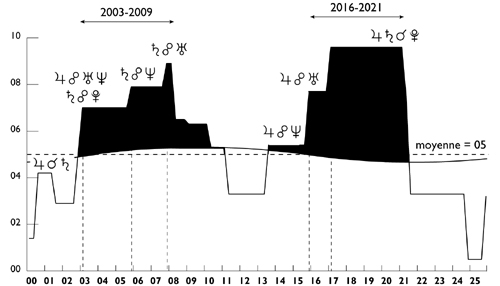
Fig. 1. The planetary concentrations are in black, at the top of the graph. The larger they are, the greater the risk of global tensions.
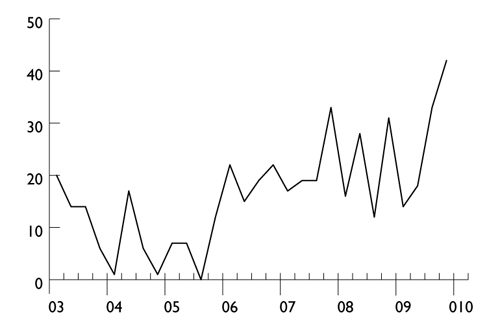
Fig. 2. The higher the sawtooth curve, the more slow-moving planets there are forming dissonant Aspects between them and the greater the risk of global tensions. The abscissa line represents the years from 2000.
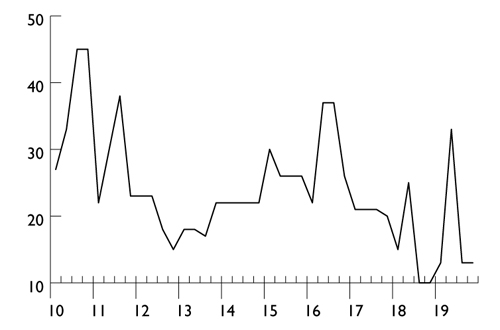
Fig. 3. Same graph, but for the years 2010–2020. Note that the years 2010–2011 will certainly still be very “hot”, in the same vein as 2008–2009. It promises…
No, I hadn’t explicitly foreseen, let alone predicted, this gigantic crash, and that’s because I was looking at this period from a broader perspective — that’s why I was talking about and planning for a “major civilizational crisis” from 2008–2009—civilizational crisis of which the stock market crash is only one indicator among many (see the passages I have bolded above). I also had not predicted the exact date when this crisis would occur, since this dated accuracy is of no importance whatsoever and cannot be predicted from a purely astrological point of view. It was not the planets that created the subprime crisis (while waiting for the Hedge Funds and LBOs which will soon be triggered), but human greed in a context of financial deregulation. It is therefore not the planets that will put an end to this crisis. As I wrote in this article, “What is not predictable with the means of astrology alone is what men will do with these planetary incentives. Simplifying, astrology makes it possible to predict what are the highlights of collective evolution, of history… but it only knows the containers of these periods, and not their contents. These depend on the conditions of earthly existence of peoples, nations, societies, all things that are not inscribed in Heaven. Despite the fact that the two world wars of the 20th century fit exactly within important periods of concentration of the slow planets, astrology alone does not allow us to predict with certainty the great collective catastrophes. Otherwise, humanity would have experienced world wars during the peaks of 1976–1984 and 1989–1997, whatever… The great “classic” wars which change the course of history, with battlefields, have since World War II transformed into modern wars: economic”.
And besides, others had perfectly planned and predicted this crash without being astrologers… and outside the traditional mainstream media, all more or less subservient to the market economy governed by globalized shareholder and financial capitalism.
This crash, could I have predicted it explicitly? Yes and no. Let me explain.
Yes, because like a lot of people outside of most economists, financiers, stockbrokers and bankers, I knew for a long time that we were going straight into the wall and that the date when the percussion would take place was getting closer and closer. I was just wondering, from a strictly astrological point of view if it would be between 2003 and 2010 or between 2016 and 2021. In view of the crisis of subprime of which I knew nothing and of which I knew the fatal outcome was near, I could have attempted this prediction. But that didn’t interest me. What interested me was the major civilizational crisis.
No, because I refuse sensationalism… and because I didn’t expect this crazy system to collapse so quickly and so brutally.
By observing the graph for the period 2003–2021, we see that the acute phase of the current crisis will end in 2010. A brief period of planetary deconcentration follows (2010–2016); then, a new period of very strong planetary concentration. What predictions can be drawn from such a situation? In the best case (therefore the least plausible given human nature and the all-out disasters that overwhelm the planet), these five or six years of false respite (planetary concentrations = tensions and planetary dispersions = relaxations) could be put to good use to reorganize globalization in a less unbalanced perspective… But let’s not dream: it is not in such a short period of time that we will be able to repair such immeasurable damage. 2010–2016 is more likely to be a period of gloomy and insidiously tense stagnation, fraught with future and latent wars, a bit like a solid hangover, which will precede a resurgence of the global crisis, with colossal power, between 2016 and 2021. We can then expect the worst: riots and wars such as the industrialized Western world had not experienced for a long time. As Leonard Cohen sang in 1992, “I’ve seen the future, brother: it is murder”. I hope I’m wrong but I don’t believe so.
Finally, I fully subscribe to the end of Serge Bret-Morel’s article… even if he is not a member of Ariana: “Today, neither the methods nor the results obtained seem sufficiently detailed for their authors to be able to express the confidence that is often theirs. Astrology needs permanent self-criticism so as not to fall into the easy interpretations it too often abuses. When the methods have been reviewed and improved, why not discuss again the possible claims of stock market astrology? But before that”…
However, in an article written on 19/02/2008, an astrologer had indeed predicted the big catamaran for 2008–2009.
▶ Global astrology: a method
▶ Declination concentration-dispersion index
▶ Élizabeth Teissier’s avian flu
▶ Conditioning in global astrology
▶ Élizabeth Teissier, Pluto in Scorpio & the AIDS epidemic
▶ Thoughts on global astrology
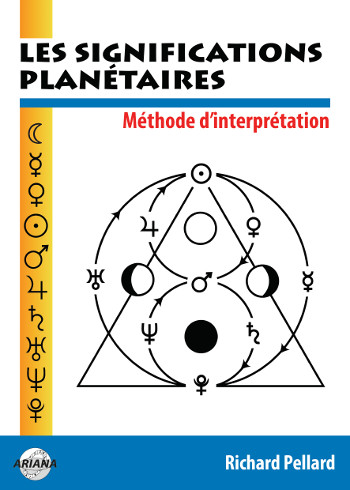
Les significations planétaires
par
620 pages. Illustrations en couleur.
La décision de ne traiter dans ce livre que des significations planétaires ne repose pas sur une sous-estimation du rôle des Signes du zodiaque et des Maisons. Le traditionnel trio Planètes-Zodiaque-Maisons est en effet l’expression d’une structure qui classe ces trois plans selon leur ordre de préséance et dans ce triptyque hiérarchisé, les Planètes occupent le premier rang.
La première partie de ce livre rassemble donc, sous une forme abondamment illustrée de schémas pédagogiques et tableaux explicatifs, une édition originale revue, augmentée et actualisée des textes consacrés aux significations planétaires telles qu’elles ont été définies par l’astrologie conditionaliste et une présentation détaillée des méthodes de hiérarchisation planétaire et d’interprétation accompagnées de nombreux exemples concrets illustrés par des Thèmes de célébrités.
La deuxième partie est consacrée, d’une part à une présentation critique des fondements traditionnels des significations planétaires, d’autre part à une présentation des rapports entre signaux et symboles, astrologie et psychologie. Enfin, la troisième partie présente brièvement les racines astrométriques des significations planétaires… et propose une voie de sortie de l’astrologie pour accéder à une plus vaste dimension noologique et spirituelle qui la prolonge et la contient.
Téléchargez-le dès maintenant dans notre boutique
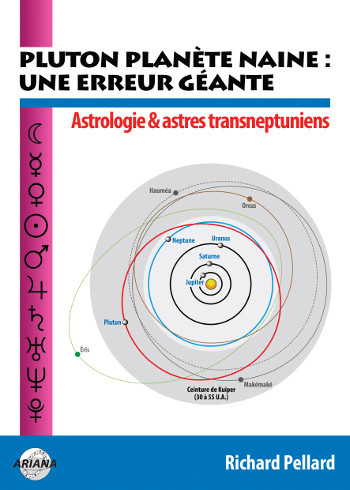
Pluton planète naine : une erreur géante
par
117 pages. Illustrations en couleur.
Pluton ne fait plus partie des planètes majeures de notre système solaire : telle est la décision prise par une infime minorité d’astronomes lors de l’Assemblée Générale de l’Union Astronomique Internationale qui s’est tenue à Prague en août 2006. Elle est reléguée au rang de “planète naine”, au même titre que les nombreux astres découverts au-delà de son orbite.
Ce livre récapitule et analyse en détail le pourquoi et le comment de cette incroyable et irrationnelle décision contestée par de très nombreux astronomes de premier plan. Quelles sont les effets de cette “nanification” de Pluton sur son statut astrologique ? Faut-il remettre en question son influence et ses significations astro-psychologiques qui semblaient avérées depuis sa découverte en 1930 ? Les “plutoniens” ont-ils cessé d’exister depuis cette décision charlatanesque ? Ce livre pose également le problème des astres transplutoniens nouvellement découverts. Quel statut astrologique et quelles influences et significations précises leur accorder ?
Enfin, cet ouvrage propose une vision unitaire du système solaire qui démontre, chiffes et arguments rationnels à l’appui, que Pluton en est toujours un élément essentiel, ce qui est loin d’être le cas pour les autres astres au-delà de son orbite. Après avoir lu ce livre, vous saurez quoi répondre à ceux qui pensent avoir trouvé, avec l’exclusion de Pluton du cortège planétaire traditionnel, un nouvel argument contre l’astrologie !
Téléchargez-le dès maintenant dans notre boutique